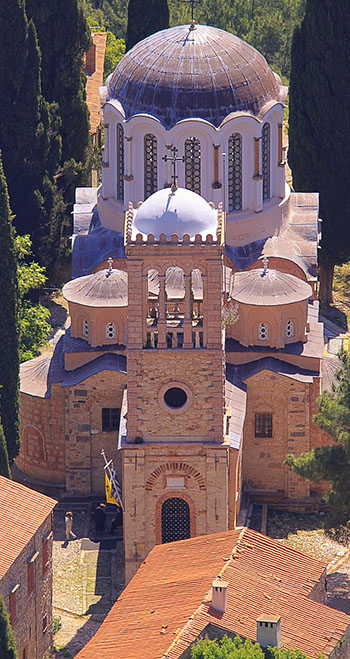
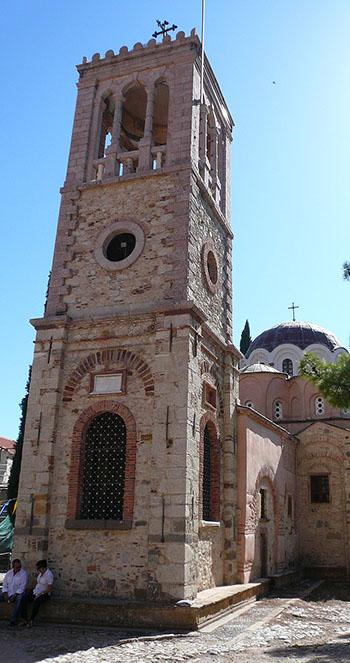
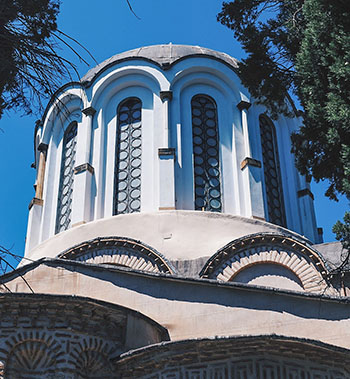
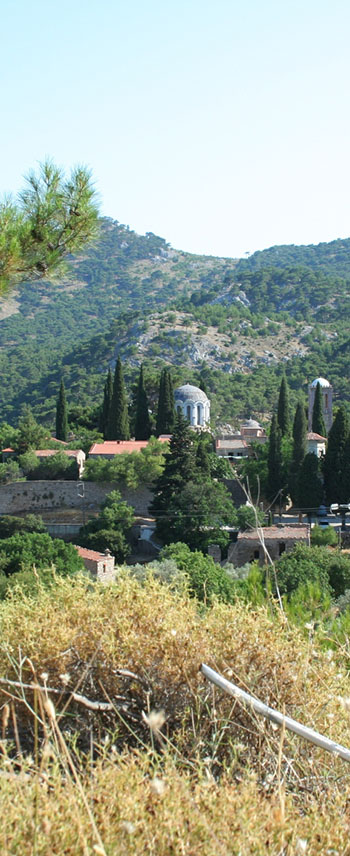
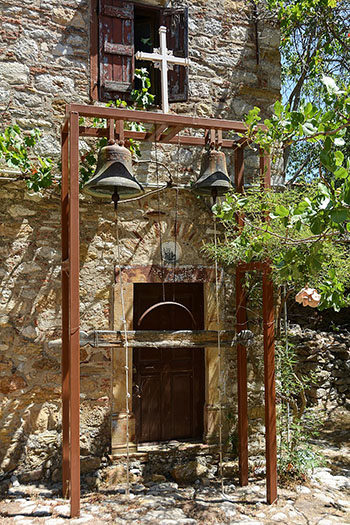
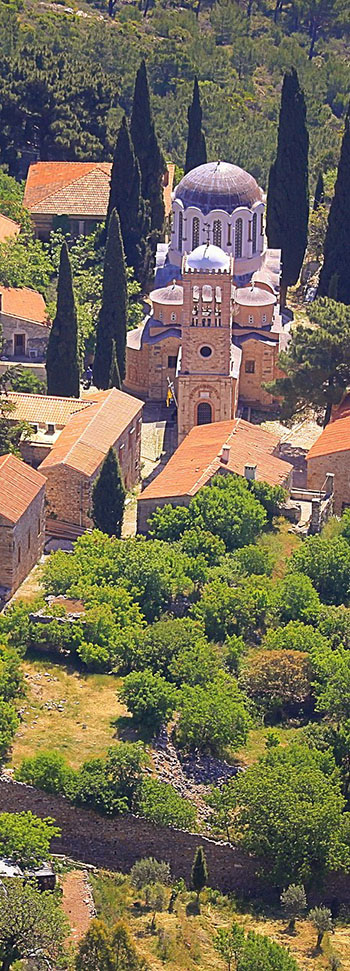
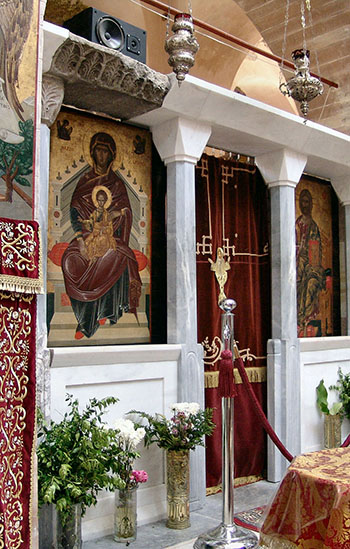

Mosaics of Nea Moni on Chios
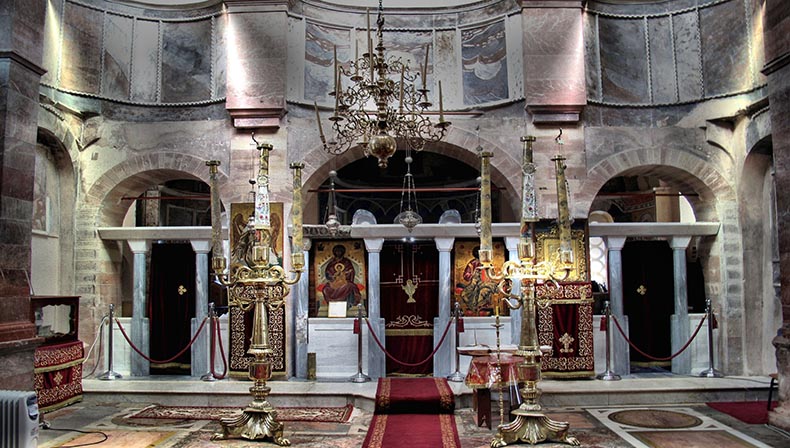 Above is a view of the eastern wall of the nave. The central apse is flanked by two prothesis. Across them is a marble iconostasis with is a restoration of the original which survived in fragments. Much later it was encased in a wood iconostasis which caught fire and burned in the 19th century, damaging this area of the church. The floor is set with beautiful slabs of colored marble.
Above is a view of the eastern wall of the nave. The central apse is flanked by two prothesis. Across them is a marble iconostasis with is a restoration of the original which survived in fragments. Much later it was encased in a wood iconostasis which caught fire and burned in the 19th century, damaging this area of the church. The floor is set with beautiful slabs of colored marble.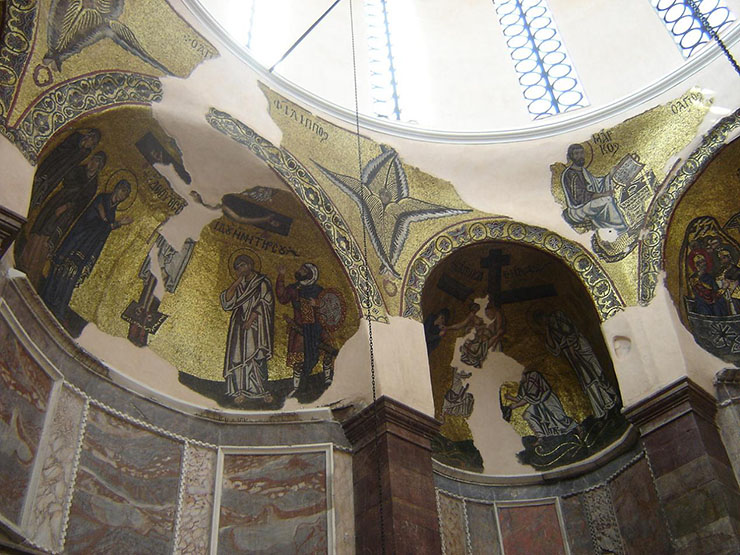 Above on the left you can see the crucifixion of Christ. Next to it is the mosaic of a Seraphim. Next there is a damaged mosaic of the descent from the cross. To the far right is the evangelist Luke. Almost all of the mosaics in the nave were lifted in the 1948 restoration from their original setting beds and relaid in fresh plaster. The beautiful colored marble panels are made of local marble from Chios. The red pilasters were originally double columns.
Above on the left you can see the crucifixion of Christ. Next to it is the mosaic of a Seraphim. Next there is a damaged mosaic of the descent from the cross. To the far right is the evangelist Luke. Almost all of the mosaics in the nave were lifted in the 1948 restoration from their original setting beds and relaid in fresh plaster. The beautiful colored marble panels are made of local marble from Chios. The red pilasters were originally double columns.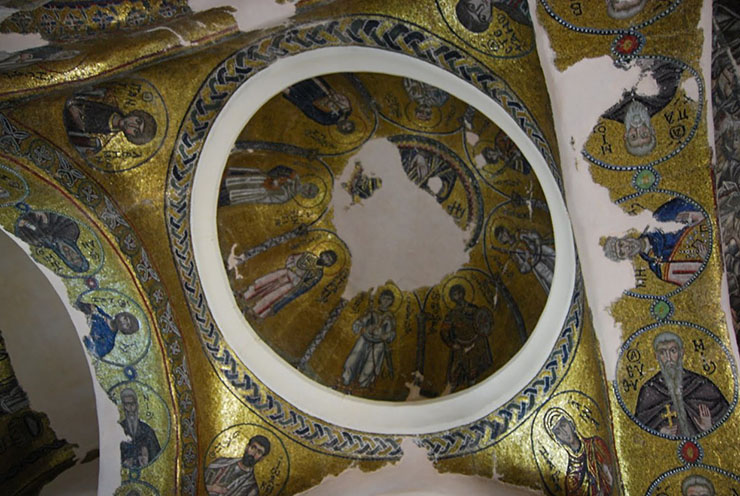
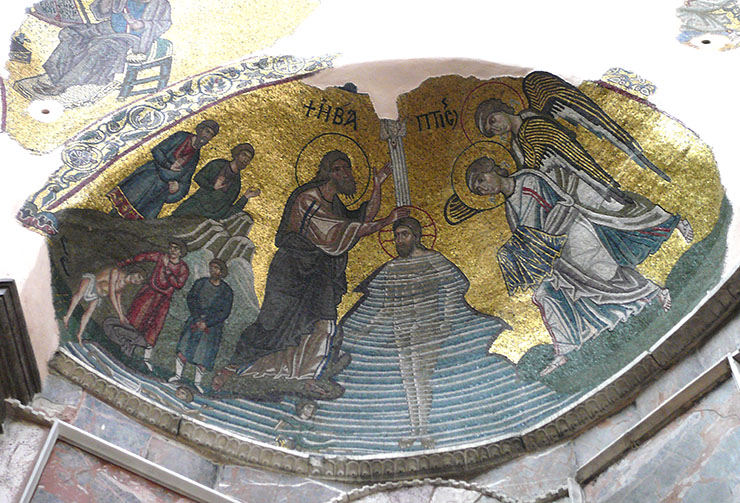 Above is a mosaic of the Baptism of Christ by John the Baptist in the river Jordan. The Holy Spirit in the form of a dove descends from Heaven
Above is a mosaic of the Baptism of Christ by John the Baptist in the river Jordan. The Holy Spirit in the form of a dove descends from Heaven
The church "New Monastery" - Nea Moni - was built by the Byzantine emperor Constantine IX Monomachos who reigned from 1042 - 1055. Before he received the crown he was in exile in the city of Mytilene, an ancient Greek city on the coast of Asia Minor. Two monks, NIcetas and Joseph from the neighboring monasteries on Mount Provateion, Nicetas, visited him with a prediction that he would become emperor. Monks were always making predictions like this one with the expectation that they might end up becoming fact and thus generating money and support for their monasteries. Constantine married the August Zoe - you can learn more about that here. The monks from Provateion approached Constantine for their reward and were granted a new church of any design they liked in Constantinople, except Hagia Sophia. They chose the imperial burial chapel of Constantine which was attached to the great church of Holy Apostles. In the plan of New Moni one can see the the shape of mausoleum with niches surrounding a central space. in these niches were placed the great marble and porphyry tombs of the dead emperors. The church might have had two tiers of columns and was decorated in rich red marbles. The chapel of Constantine is long gone. What remained after 1453 was swept way by Mehmet II and its building materials were incorporated in the great mosque he built on the site to replace the famous domed church of Justinian.
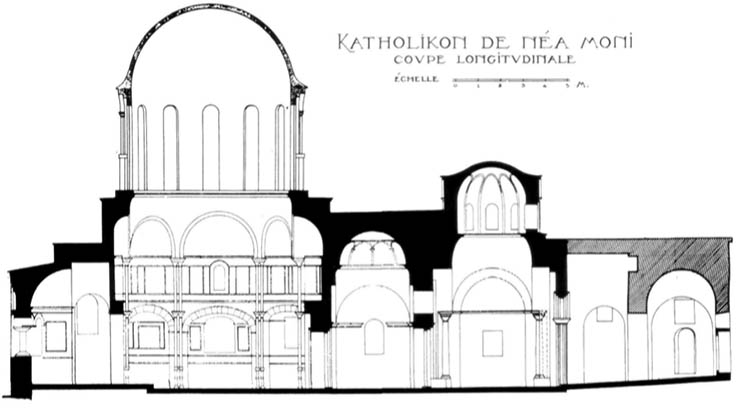
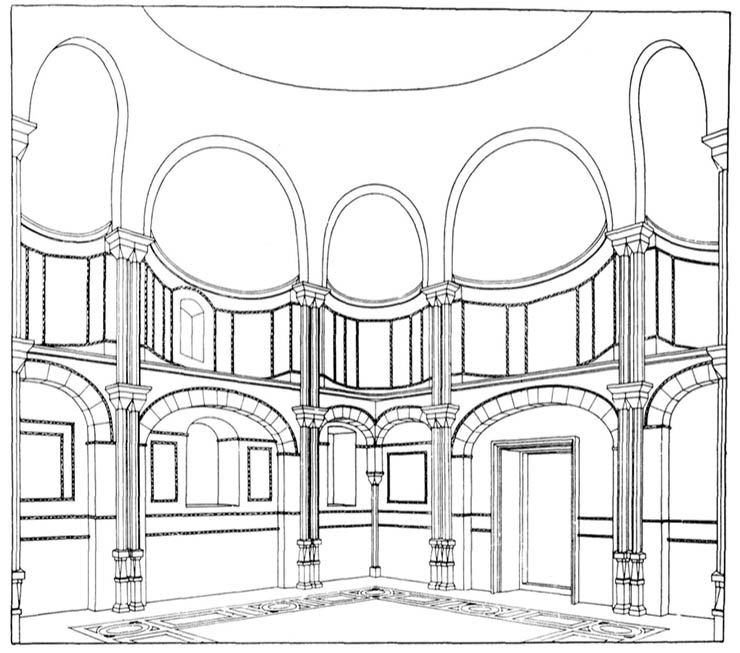 The church was built and decorated in 12 years by a team of master builders from Constantinople. 12 years was the exact number of years of Constantine's reign. In 1049 an imperial order was issued recognizing the new church building existed and was close enough to completion that it could host services.
The church was built and decorated in 12 years by a team of master builders from Constantinople. 12 years was the exact number of years of Constantine's reign. In 1049 an imperial order was issued recognizing the new church building existed and was close enough to completion that it could host services.
In the interior they used a selection of marble brought from Constantinople and newly quarried stone from the island, including the rich red marble seen inside. The interior seen today looks very much like it did in the 11th century. The main changes were the removal in the 20th century of the two-tiered colonnettes and their replacement with red stone piers, and the replacement of the dome after an earthquake in 1881. Local red marble was also used to restore damaged revetment in the lowest two zones of the naos. The church has been plagued by earthquakes and fires since it was built. The wooden iconostasis caught fire and burned causing much damage on the eastern side of the nave and in the three apses there.
Fragments of the original marble iconostasis have survived until today. In a restoration of the church and its mosaics in 1948 the iconostasis was crudely rebuilt in marble.
The mosaic were done as soon as the church was ready for them. A workshop from Constantinople made them. There were probably two teams - one which did the nave and the other that did the narthezx. This is apparent because of changes in technique and style between the two areas of the church. There seem to have been two masters assisted by teams of workers. These people included plasterers as well as artists and assistants who cut the mosaic cubes and laid them in the wet plaster. Each section to be done was frescoed with detailed paintings by the master artists. These masters also did the most important figures, like the Pantokrator in the dome and the Oran Virgin in the apse themselves. An examination of the mosaics shows a range of sizes of cubes. They range from the size of a pinhead to cubes that are 4-8mm. The most consistent in size are the gold mosaic of the background, which are quite small. The image of Saint Theodore of Studion has the smallest and greatest number of cubes in its face, this indicates the importance of this monk to the monks who lived at Nea Moni.
There is a great deal of variance in the sizes of the figures in the mosaics. For example the sizes of the images of the archangels in the prosthesis apses are larger than that of the Orant Theotokos in the central apse. In scenes with multiple figures these often do not match and, for example in the Baptism, the figures of the angels are larger than that of Christ. There are mistakes in drawing in many places. The figure of Mark the Evangelist in the nave has badly drawn hand and in the Anastasis a figure has two left hands. The master artist who drew these left the execution of the mosaic to his assistants who did not correct these things in his wake. Had the master artist laid the mosaic himself he would have corrected the mistakes.
The glass mosaic came to the project in sheets and was cut onsite. It was made in Constantinople glass factories. Marble and stone were also used for cubes. Many of the reds were made from the same local quarries that supplied revetment and architectural elements on Chios. There were enormous quantities of gold mosaic to cut - even the clear amber glass edges of these sheets were used in the mosaics. The mosaic artists worked on scaffolds to further cut the cubes to fit the designs. This produced a shower of tiny glass shavings all over the scaffold which fell to the floor beneath. This debris has to be constantly cleaned up by workers. In this project we can see a large number of expensive glass colors being used, like blue ultramarine. There seems to have been need to economize as the project moved forward as they were well supplied by the Imperial agents who supervised and managed it.
A large number of shades in marble were used for the faces and white clothes. White limestone was also used as a cheap alternative which unfortunately weathers badly and cannot be cleaned.
The style of the mosaics is closer to Saint Sophia in Kiev than the beautiful serene and neoclassical figures at Daphni. The faces have strong contrasts and the figures are unclassical and clumsy. There is no attempt at elegance. Looking at the expressive figures of Christ, Constantine and Zoe in Hagia Sophia we can see artists who were closely associated with the work here. The monks who convinced Constantine to build New Moni seem to have been sophisticated city dwellers who would have known beautiful mosaics from there time living in Constantinople. They appear to have taken no interest in the religious philosophy or artist qualities of the work. They just wanted to see it get done so they could take possession of their new monastery and its church and move in. Constantine gave the monastery properties and endowments to insure the comfort of the monks, the expansion of the facilities and the preservation of the complex. The monks, Nietas and Joseph ran into trouble and found themselves in prison in Constantinople being charged with sorcery and other crimes. They managed to beat the charges, probably by paying big bribes.
It is possible the the Church of Nea Moni and its decoration was very close in style to another famous project of Constantine's - the Monastery and Church of Saint George of the Mangana in Constantinople. You can learn more about it here.
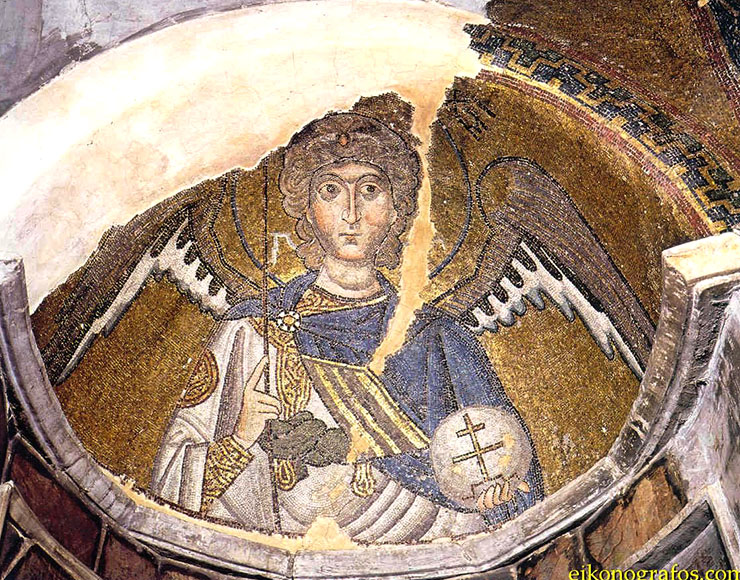 Here is a mosaic of the Archangel Michael in the apse of the left prosthesis. He is dressed in classical robes made up of white proconnesian marble and limestone cubes shaded with violet glass in three shades. Michael carries a glass orb decorated with a golden cross. The face is made up of small marble cubes in various shades of white and pink. The shadow of the face are in olive-colored cubes. His hair is the same color with gold highlights. The blue robe - his chlamys -for this archangel is usually red.
Here is a mosaic of the Archangel Michael in the apse of the left prosthesis. He is dressed in classical robes made up of white proconnesian marble and limestone cubes shaded with violet glass in three shades. Michael carries a glass orb decorated with a golden cross. The face is made up of small marble cubes in various shades of white and pink. The shadow of the face are in olive-colored cubes. His hair is the same color with gold highlights. The blue robe - his chlamys -for this archangel is usually red.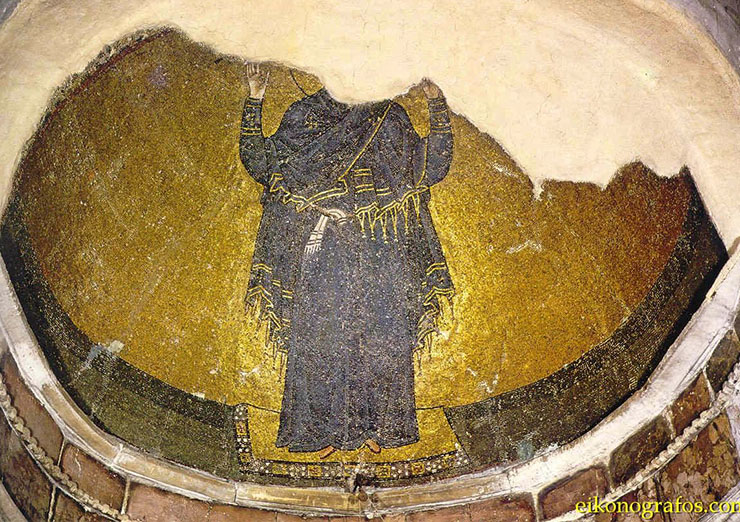 This image of the Theotokos Oranta is also called the Great Panaghia. This image is based on one of the Theotokos in the famous and popular Blachernae Church of the Theotokos in Constantinople. Her maphorion is made of blue glass cubes and the lines in it are drawn in black glass. Dark glass mosaic reflects more light which is why the dark lines stand out. Her kerchief is made of white limestone. The feet of the Virgin, which are composed of terracotta cubes, are very small. The missing head would have been tiny as well in relation to the body. She stands on a jeweled platform. You can see fire damage on the marble banding of the apse.
This image of the Theotokos Oranta is also called the Great Panaghia. This image is based on one of the Theotokos in the famous and popular Blachernae Church of the Theotokos in Constantinople. Her maphorion is made of blue glass cubes and the lines in it are drawn in black glass. Dark glass mosaic reflects more light which is why the dark lines stand out. Her kerchief is made of white limestone. The feet of the Virgin, which are composed of terracotta cubes, are very small. The missing head would have been tiny as well in relation to the body. She stands on a jeweled platform. You can see fire damage on the marble banding of the apse.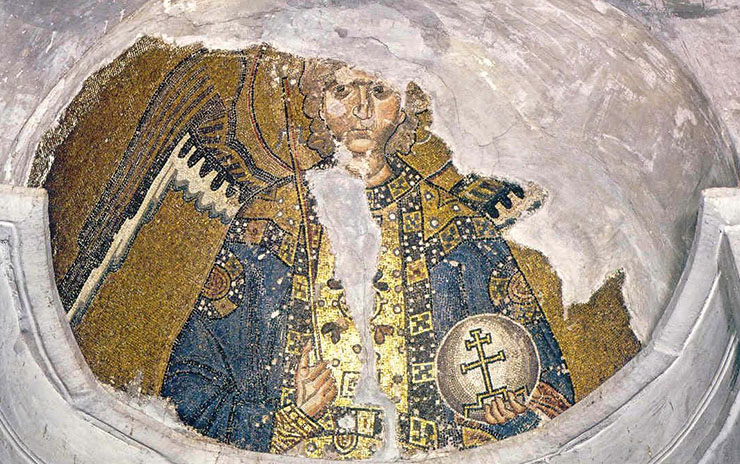 Here we see the Archangel Gabriel in the apse of the right prosthesis. This mosaic is badly damaged. Here he is dressed in Imperial garb, the jeweled stole is called a loros. All of the pearls are made of limestone cubes outlined with violet glass ones. This doesn't match Michael and I have never seen it anywhere else, normally they are dressed the same. Also, normally the imperial robes are Imperial purple or red, not blue.
Here we see the Archangel Gabriel in the apse of the right prosthesis. This mosaic is badly damaged. Here he is dressed in Imperial garb, the jeweled stole is called a loros. All of the pearls are made of limestone cubes outlined with violet glass ones. This doesn't match Michael and I have never seen it anywhere else, normally they are dressed the same. Also, normally the imperial robes are Imperial purple or red, not blue.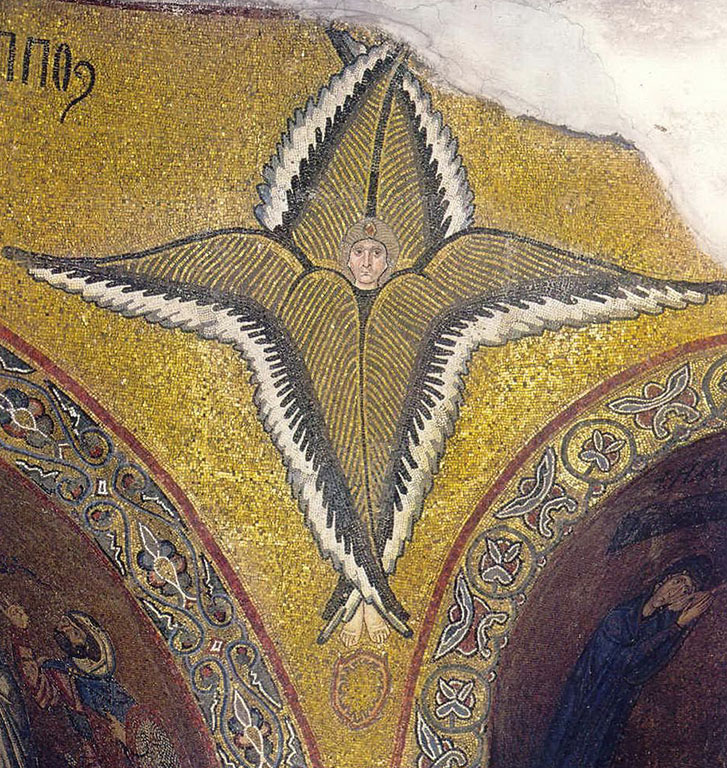 Above is an image of a winged seraphim.They are around 4 feet tall. The wings are made of three rows of brown glass separated by single row of gold. The faces are made of tones of marble and limestone. The eyebrows are made of dark brown cubes which flash. The hair is made of light brown glass with curls of gold. In the center of the hair the seraphim wears a silk hair band set with a red jewel. Below the feet of the angel is a red wheel - a feature mentioned in biblical texts referring to Seraphim and their worship of God.
Above is an image of a winged seraphim.They are around 4 feet tall. The wings are made of three rows of brown glass separated by single row of gold. The faces are made of tones of marble and limestone. The eyebrows are made of dark brown cubes which flash. The hair is made of light brown glass with curls of gold. In the center of the hair the seraphim wears a silk hair band set with a red jewel. Below the feet of the angel is a red wheel - a feature mentioned in biblical texts referring to Seraphim and their worship of God.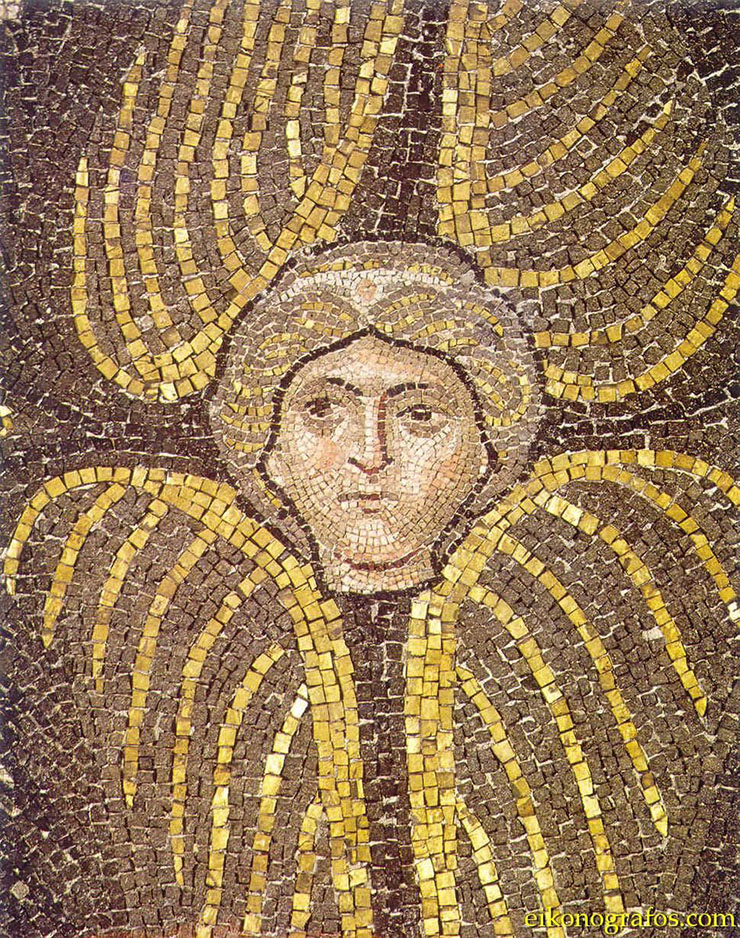
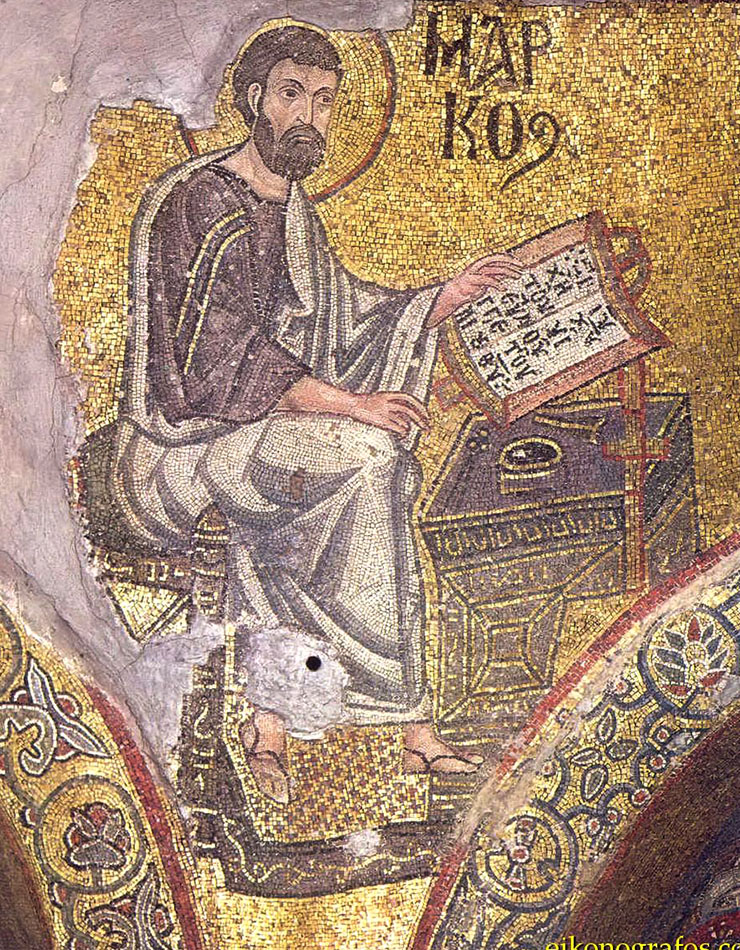 Here we see the evangelist Mark. There were originally four evangelists of which three survive. The evangelist is seated on a wooden throne. In front of him is a chest set with the tools of a scribe. He has the bible open and is reading from it. The left hand which is pointing at the Gospel is very strangely drawn. Is that thumb or a finger? The face looks very flat, this might be due to the discoloration of the tesserae. White limestone does this and it is very hard to clean. Mark is wearing a chiton and himation. As in all of the white robes of figures in the nave it is made up of white proconnesian marble, white limestone and three shades of violet glass.
Here we see the evangelist Mark. There were originally four evangelists of which three survive. The evangelist is seated on a wooden throne. In front of him is a chest set with the tools of a scribe. He has the bible open and is reading from it. The left hand which is pointing at the Gospel is very strangely drawn. Is that thumb or a finger? The face looks very flat, this might be due to the discoloration of the tesserae. White limestone does this and it is very hard to clean. Mark is wearing a chiton and himation. As in all of the white robes of figures in the nave it is made up of white proconnesian marble, white limestone and three shades of violet glass.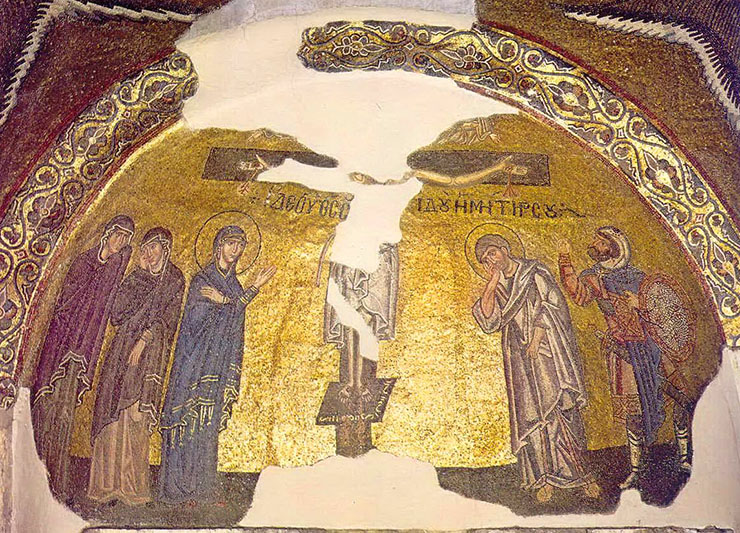 Above we see Mary and John on either side of the cross of Christ. To the far right is the figure of the centurion (soldier) in a military uniform. Above the cross are the remnants of two flying angels who are mourning Christ's suffering and death. The figure of Christ has mostly disappeared.
Above we see Mary and John on either side of the cross of Christ. To the far right is the figure of the centurion (soldier) in a military uniform. Above the cross are the remnants of two flying angels who are mourning Christ's suffering and death. The figure of Christ has mostly disappeared.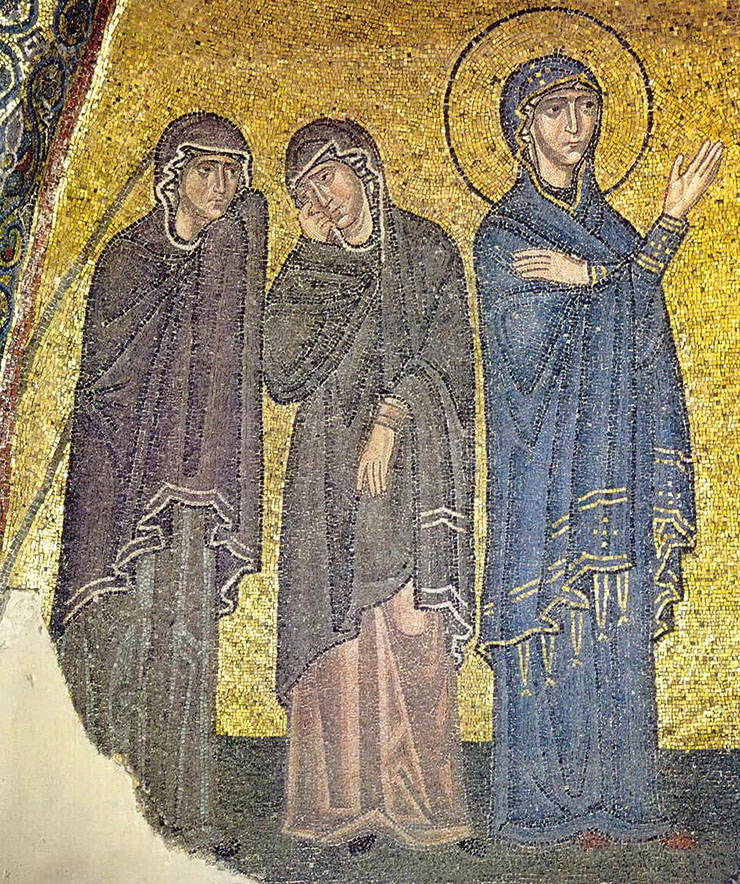 Many of the figures of Nea Moni, like this image of the Theotokos, have bold and dramatic modeling in their faces. of these three figures only the Theotokos has a nimbus-halo. Her maphorion is made of three shades of blue glass outlined with black. It has bands of gold and gold tassels.
Many of the figures of Nea Moni, like this image of the Theotokos, have bold and dramatic modeling in their faces. of these three figures only the Theotokos has a nimbus-halo. Her maphorion is made of three shades of blue glass outlined with black. It has bands of gold and gold tassels.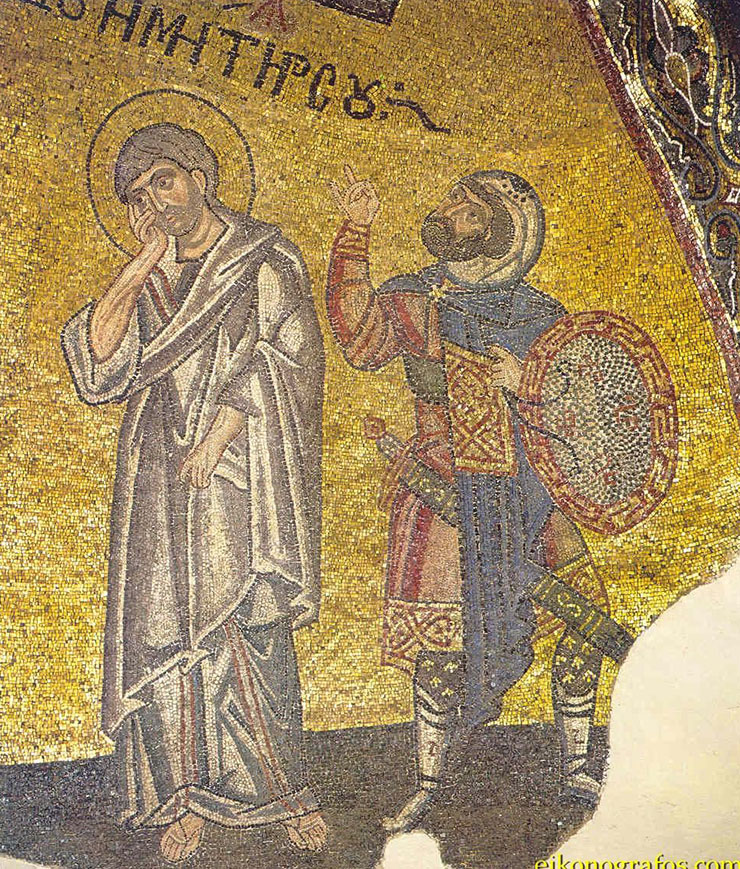 John the apostle is shown with a beard, this is an unusual way to portray him, normally he is clean shaven in part to reflect his age.
John the apostle is shown with a beard, this is an unusual way to portray him, normally he is clean shaven in part to reflect his age.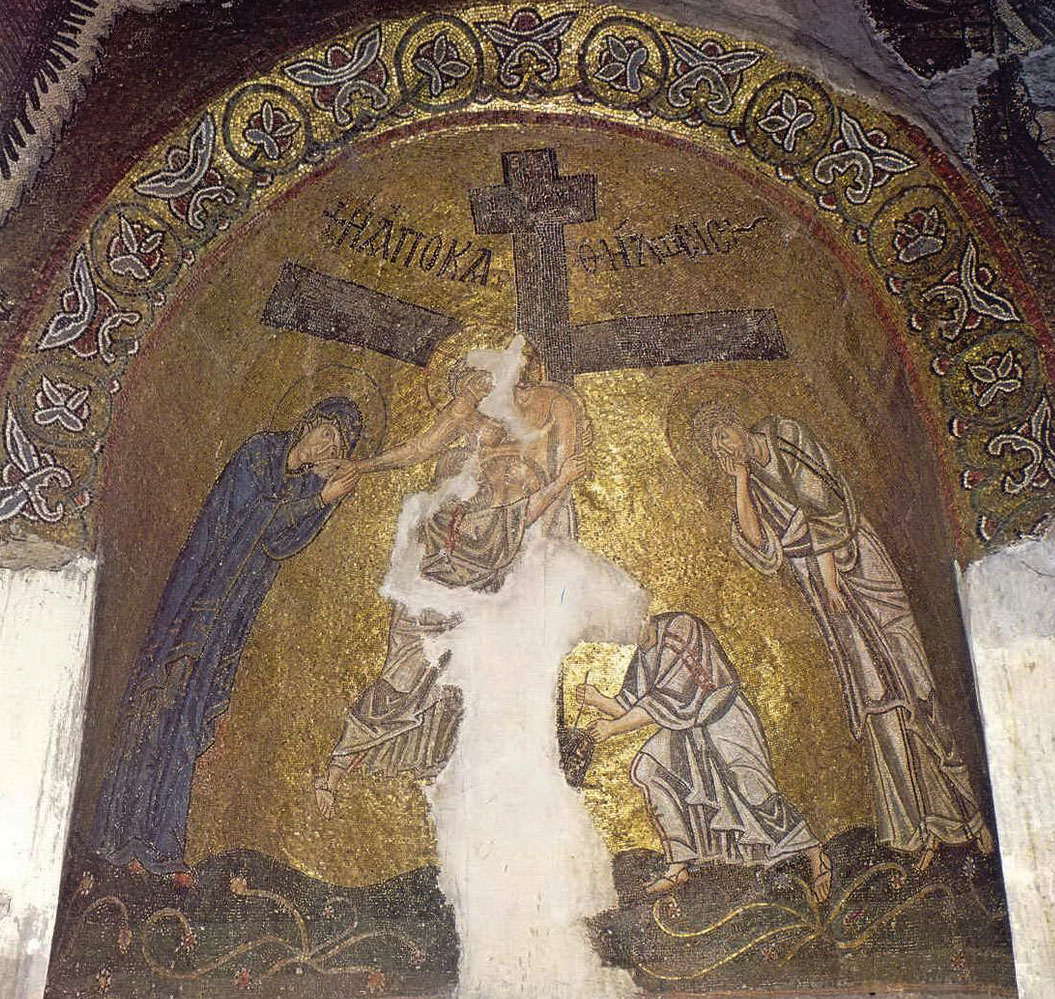 Here we see the descent from the cross, Mary tenderly holds the hand of Christ to her face. John "the Beloved" is on the other side of the cross.
Here we see the descent from the cross, Mary tenderly holds the hand of Christ to her face. John "the Beloved" is on the other side of the cross.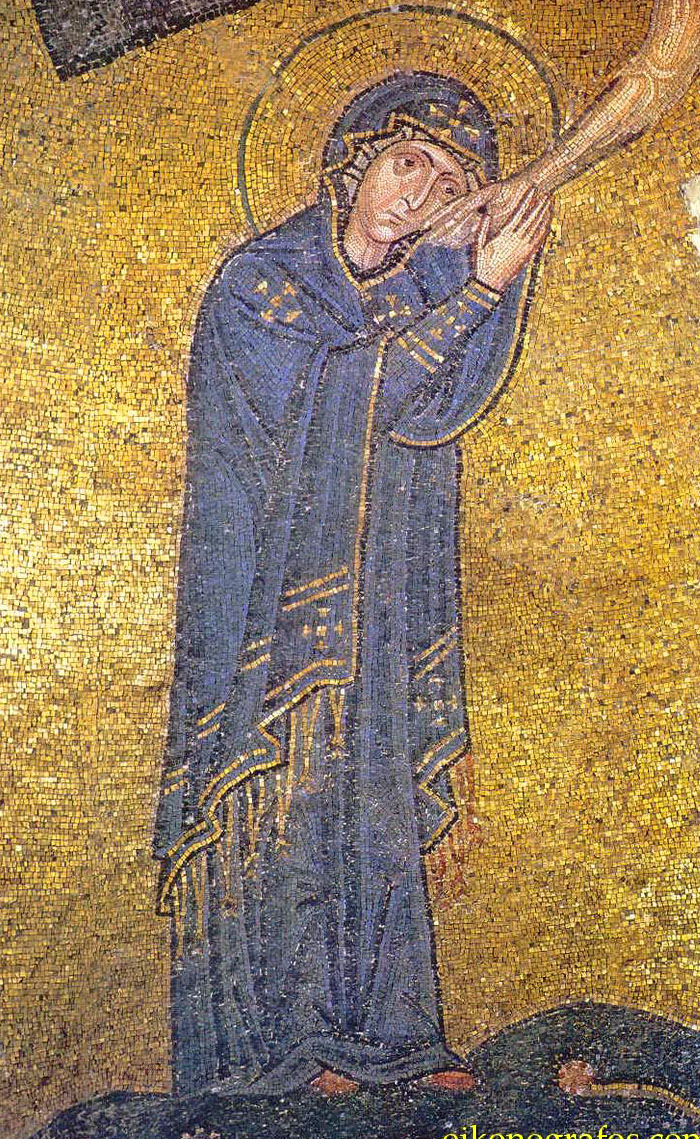
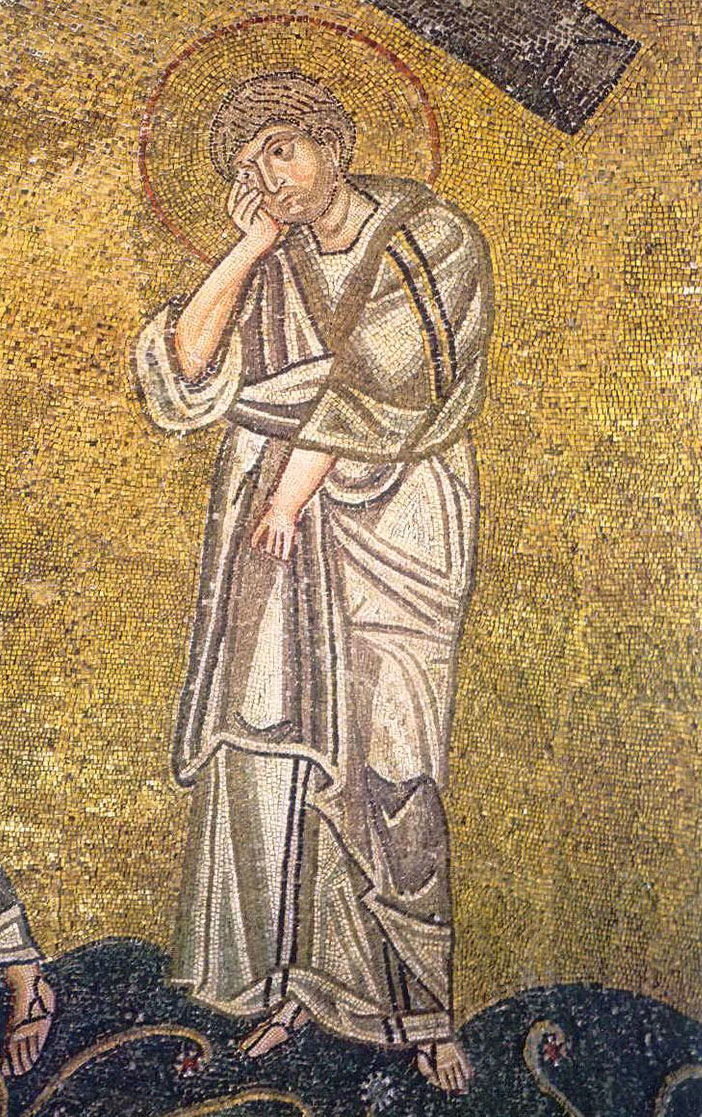
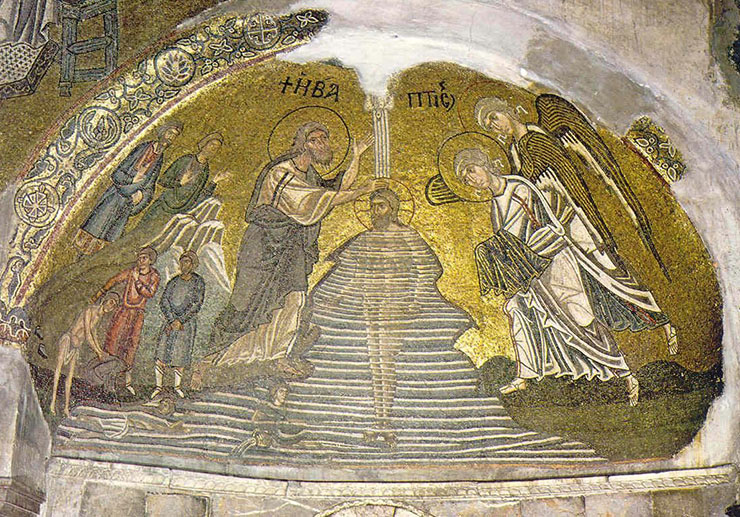 Here is the scene showing the Baptism of Christ. the figures are ll different sizes with the angels and John the Baptist larger than Christ. The body of Christ is shown beneath the waters of the river Jordan, which cross Christ in parallel lines of white proconnesian marble, white limestone and blue-gray violet glass in two shades. The hair of the angels is made of olive and purple glass, outlined in black
Here is the scene showing the Baptism of Christ. the figures are ll different sizes with the angels and John the Baptist larger than Christ. The body of Christ is shown beneath the waters of the river Jordan, which cross Christ in parallel lines of white proconnesian marble, white limestone and blue-gray violet glass in two shades. The hair of the angels is made of olive and purple glass, outlined in black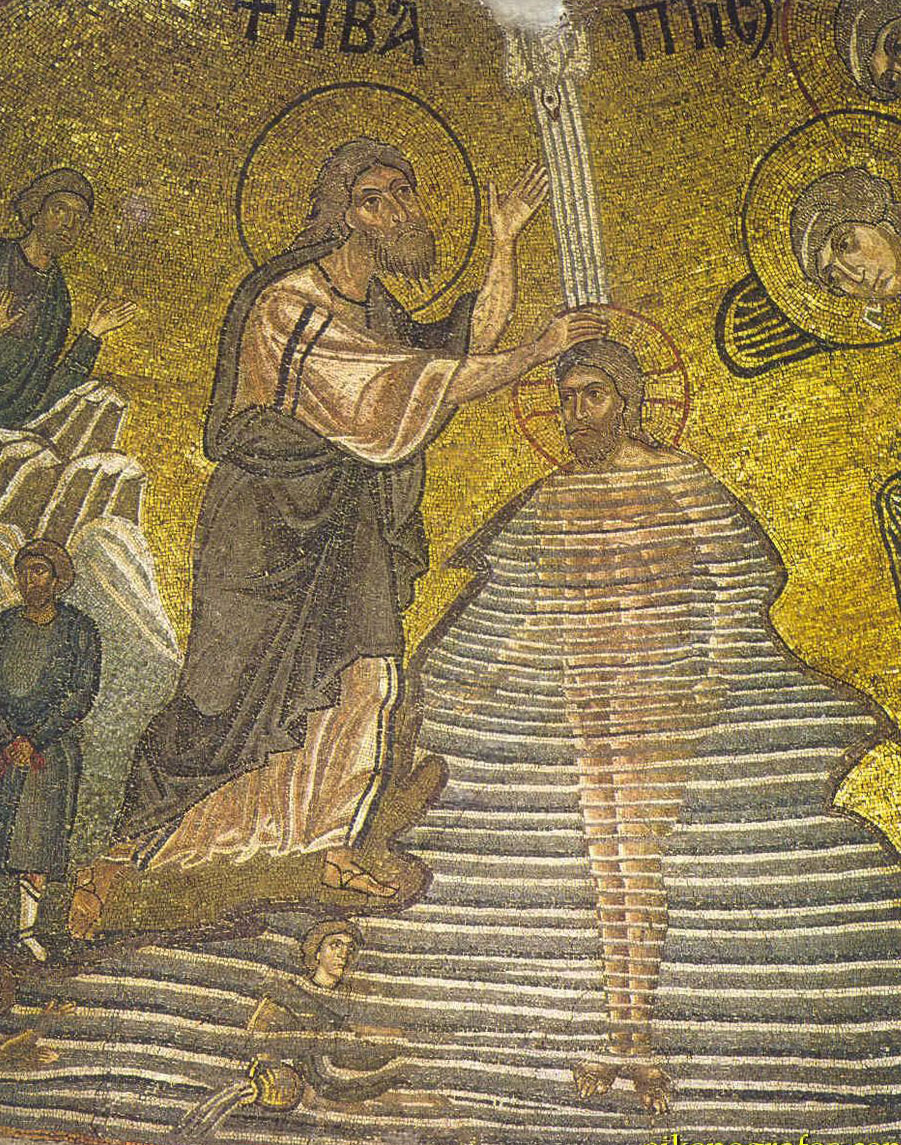 There is a great deal of freedom in the modeling of John's face. Unfortunately the white limestone cubes in it are discolored. In the water you can see a personification of the River Jordan.
There is a great deal of freedom in the modeling of John's face. Unfortunately the white limestone cubes in it are discolored. In the water you can see a personification of the River Jordan.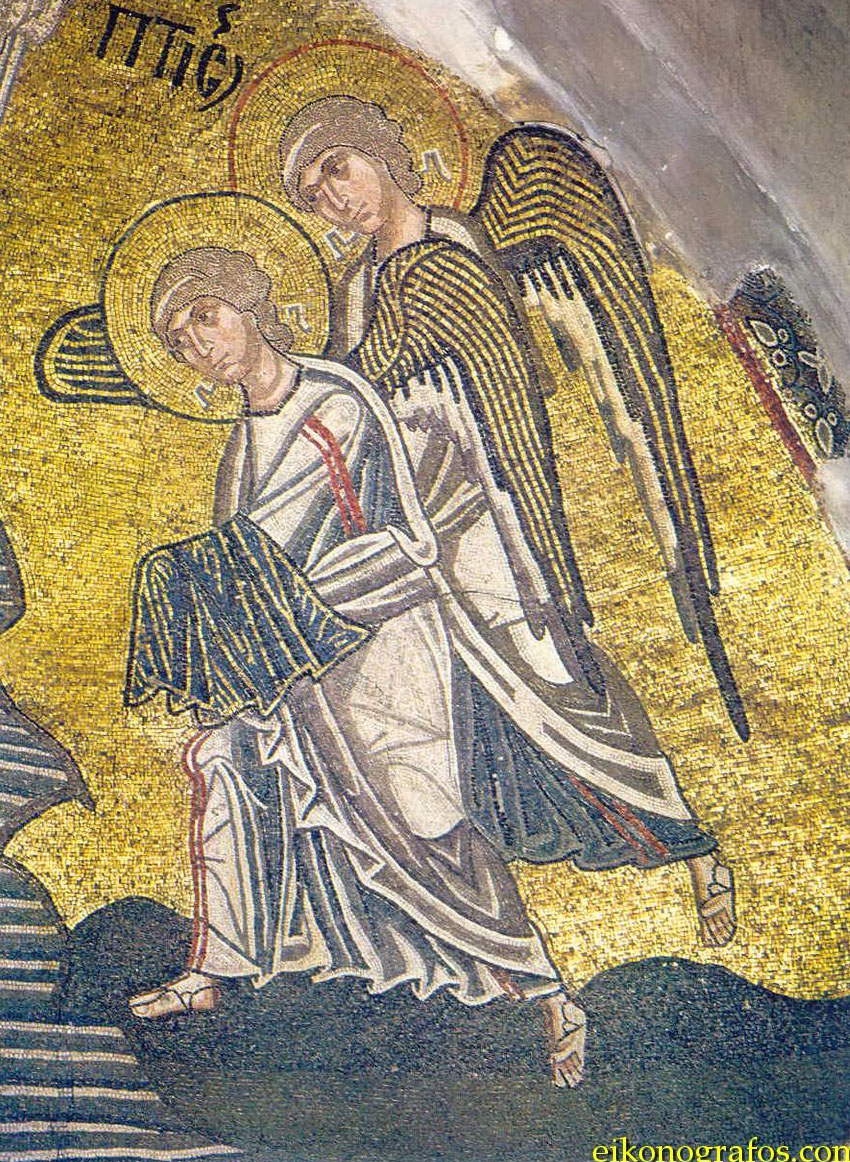 The faces of the angels are modeled in olive and marble tesserae. Their hair appears very flat, the edge is outlined in black glass. The bands on their tunics are drawn in red. The wings are made of alternating brown and gold lines.
The faces of the angels are modeled in olive and marble tesserae. Their hair appears very flat, the edge is outlined in black glass. The bands on their tunics are drawn in red. The wings are made of alternating brown and gold lines.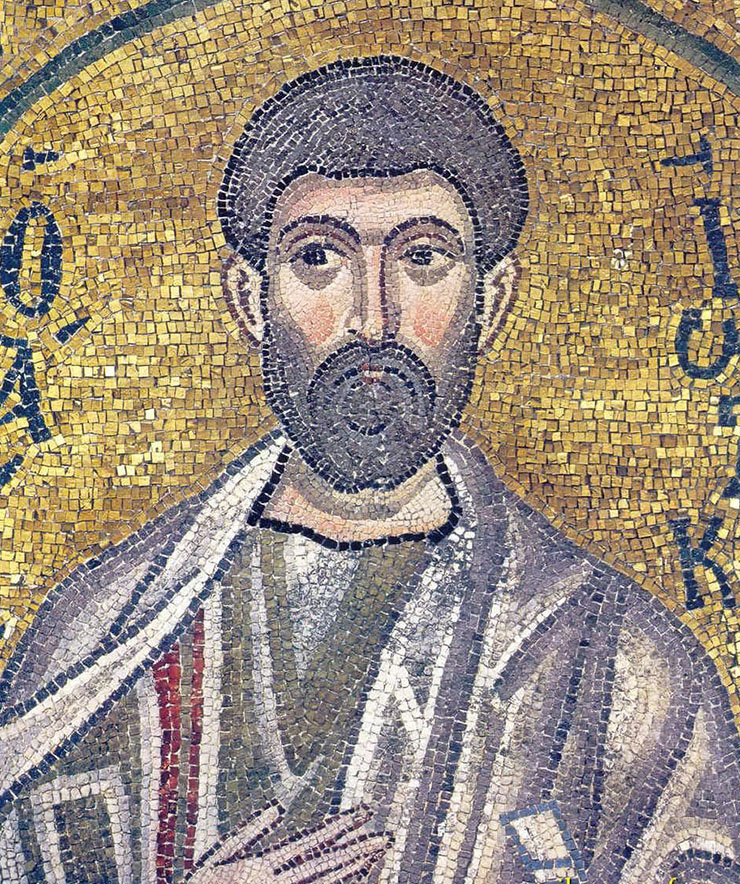 There area large numer of images of saints throughout the church. The finest have small tesserae in their faces a with sensitive modeling.
There area large numer of images of saints throughout the church. The finest have small tesserae in their faces a with sensitive modeling.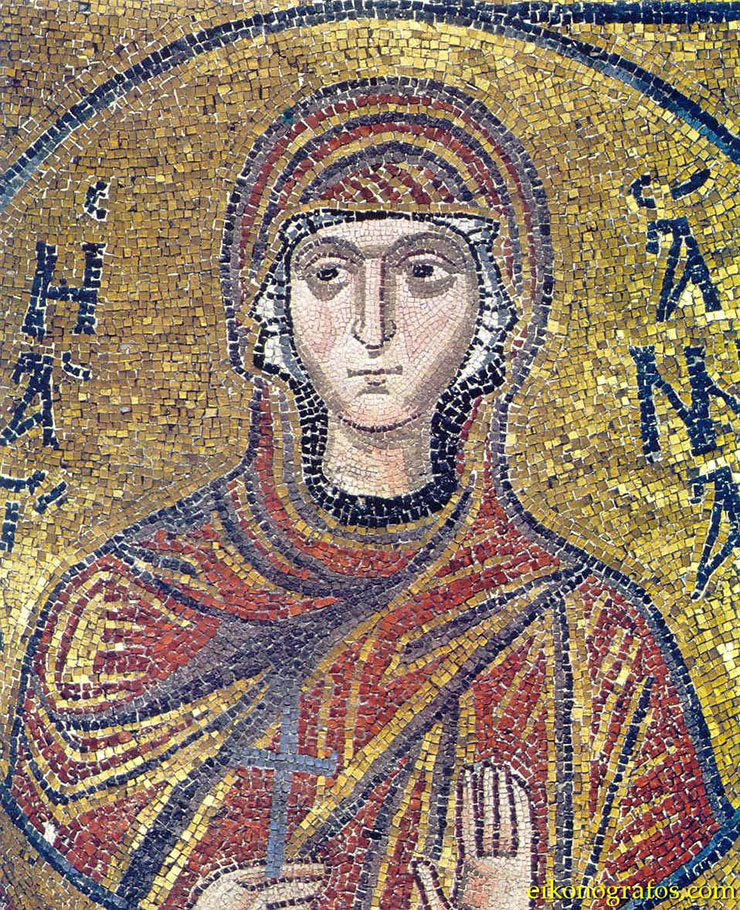 All of the pictures of mosaics came from eikonografos.com, a website formally operated by a Greek icon studio. Unfortunately, the site has not been updated in 17 years.
All of the pictures of mosaics came from eikonografos.com, a website formally operated by a Greek icon studio. Unfortunately, the site has not been updated in 17 years.




 click here for icons of christ
click here for icons of christ click here for icons of the theotokos
click here for icons of the theotokos click here for icons of angels
click here for icons of angels click here for icons of saints
click here for icons of saints








